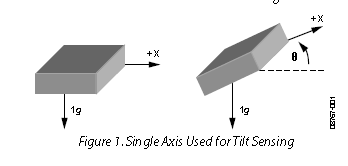Using acelerômeters to measure angles
An abstract on a simple and reliable way to measure angles with single, bi-axial, triaxial acelerômeters.
Acelerômeters may be used to identify angles of devices. The gravity has a projection on the acelerômeter axis, and with this aceleration, we can get the angle.

With simple trigonometry, the equation we get from this projection is:

But near +- 90 a big change in the angle is results in a small change in the aceleration, you can check that by looking at the sine graph. So even thoght the acelerometer has a good resolution, it won't be able to measure small angular changes. This is a table I measured with and ADXL345 and compared with a cellphone app.

As you can see the results weren't good enoght near 90 degrees for the sine function, and 0 for the coss. You can get complex results even if your acelerômeter was well calibrated, Even 1,004 is enough to create a big angular change and to result in a complex number from the sin() function.
A more precise and easier way to approach this problem is to use another axis.

With this new method, my resusts were much better in new the end-point ( 0 and 90 degrees). Look,

References:
http://www.analog.com/media/en/technical-documentation/application-notes/AN-1057.pdf.
1 comment on Using acelerômeters to measure angles:
Please log in to post comments.

first page!